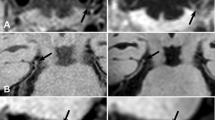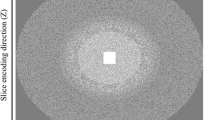Abstract
Objectives
Intracranial vessel wall magnetic resonance imaging (MRI) may improve the diagnosis of vessel wall abnormalities. Current methods are hampered by limited coverage and few contrast weightings. We present a multi-sequence protocol with whole-brain coverage for vessel wall imaging on 7.0-T MRI.
Methods
A modified magnetisation-preparation inversion recovery turbo-spin-echo (MPIR-TSE) sequence was used to obtain proton density (PD)-, T1-, and T2-weighting with 190-mm whole-brain coverage. Three observers independently scored the visibility of arterial vessel walls in five healthy volunteers, and compared the conspicuity and image contrast of all sequences. Clinical applicability was demonstrated in 17 patients with cerebrovascular disease.
Results
Conspicuity was good for all acquisitions, with best scores for the original limited-coverage sequence, followed by whole-brain coverage T2-, PD- and T1-weighted sequences, respectively. Mean vessel wall/background MR signal intensity ratios for all whole-brain sequences were similar, with higher scores for the limited-coverage MPIR-TSE sequence. Signal intensity ratios were highest in patients, for the whole-brain T1-weighted sequence.
Conclusions
The whole-brain multi-sequence vessel wall protocol can assess intracranial arterial vessel walls with full brain coverage, for different image contrast weightings. These sequences could eventually characterise intracranial vessel wall abnormalities similar to current techniques for assessing carotid artery plaques.
Key points
- Intracranial vessel wall imaging using MRI improves diagnosis of cerebrovascular diseases.
- Conventional 7-T MRI sequences cannot image the whole cerebral arterial tree.
- New whole-brain 7-T MRI sequences compare favourably with smaller-coverage sequences.
- These whole-brain sequences can demonstrate the entire cerebral arterial tree.
- These sequences should help in the diagnosis of vessel wall abnormalities.





Similar content being viewed by others
Abbreviations
- HV:
-
Healthy volunteers
- MP:
-
Magnetisation preparation mixing time
- MPIR-TSE:
-
Magnetisation preparation inversion recovery turbo-spin-echo
- NSA:
-
Number of signal averages
- AP:
-
Anterior–posterior
- RL:
-
Right-left
- SAR:
-
Specific absorption rate
- SENSE:
-
Sensitivity encoding
References
Sacco RL, Kargman DE, Gu Q, Zamanillo MC (1995) Race-ethnicity and determinants of intracranial atherosclerotic cerebral infarction. The Northern Manhattan Stroke Study. Stroke 26:14–20
Gorelick PB, Wong KS, Bae HJ, Pandey DK (2008) Large artery intracranial occlusive disease: a large worldwide burden but a relatively neglected frontier. Stroke 39:2396–2399
Bash S, Villablanca JP, Jahan R et al (2005) Intracranial vascular stenosis and occlusive disease: evaluation with CT angiography, MR angiography, and digital subtraction angiography. AJNR Am J Neuroradiol 26:1012–1021
Miyazawa N, Akiyama I, Yamagata Z (2007) Analysis of incidence and risk factors for progression in patients with intracranial steno-occlusive lesions by serial magnetic resonance angiography. Clin Neurol Neurosurg 109:680–685
Glagov S, Weisenberg E, Zarins CK, Stankunavicius R, Kolettis GJ (1987) Compensatory enlargement of human atherosclerotic coronary arteries. N Engl J Med 316:1371–1375
Stiel GM, Stiel LS, Schofer J, Donath K, Mathey DG (1989) Impact of compensatory enlargement of atherosclerotic coronary arteries on angiographic assessment of coronary artery disease. Circulation 80:1603–1609
Kiechl S, Willeit J (1999) The natural course of atherosclerosis. Part II: vascular remodeling. Bruneck Study Group. Arterioscler Thromb Vasc Biol 19:1491–1498
Niizuma K, Shimizu H, Takada S, Tominaga T (2008) Middle cerebral artery plaque imaging using 3-Tesla high-resolution MRI. J Clin Neurosci 15:1137–1141
Li ML, Xu WH, Song L et al (2009) Atherosclerosis of middle cerebral artery: evaluation with high-resolution MR imaging at 3T. Atherosclerosis 204:447–452
Swartz RH, Bhuta SS, Farb RI et al (2009) Intracranial arterial wall imaging using high-resolution 3-tesla contrast-enhanced MRI. Neurology 72:627–634
Ryu CW, Jahng GH, Kim EJ, Choi WS, Yang DM (2009) High resolution wall and lumen MRI of the middle cerebral arteries at 3 tesla. Cerebrovasc Dis 27:433–442
Xu WH, Li ML, Gao S et al (2010) In vivo high-resolution MR imaging of symptomatic and asymptomatic middle cerebral artery atherosclerotic stenosis. Atherosclerosis 212:507–511
Ma N, Jiang WJ, Lou X et al (2010) Arterial remodeling of advanced basilar atherosclerosis: a 3-tesla MRI study. Neurology 75:253–258
van der Kolk AG, Zwanenburg JJ, Brundel M et al (2011) Intracranial vessel wall imaging at 7.0-T MRI. Stroke 42:2478–2484
Aoki S, Shirouzu I, Sasaki Y et al (1995) Enhancement of the intracranial arterial wall at MR imaging: relationship to cerebral atherosclerosis. Radiology 194:477–481
Turan TN, Bonilha L, Morgan PS, Adams RJ, Chimowitz MI (2011) Intraplaque hemorrhage in symptomatic intracranial atherosclerotic disease. J Neuroimaging 21:e159–e161
Shi M, Wang S, Zhou H, Cheng Y, Feng J, Wu J (2012) Wingspan stenting of symptomatic middle cerebral artery stenosis and perioperative evaluation using high-resolution 3 Tesla MRI. J Clin Neurosci 19:912–914
Visser F, Zwanenburg JJ, Hoogduin JM, Luijten PR (2010) High-resolution magnetization-prepared 3D-FLAIR imaging at 7.0 Tesla. Magn Reson Med 64:194–202
Busse RF, Hariharan H, Vu A, Brittain JH (2006) Fast spin echo sequences with very long echo trains: design of variable refocusing flip angle schedules and generation of clinical T2 contrast. Magn Reson Med 55:1030–1037
Smit EJ, Vonken EJ, van der Schaaf IC et al (2012) Timing-invariant reconstruction for deriving high-quality CT angiographic data from cerebral CT perfusion data. Radiology 263:216–225
Vergouwen MD, Silver FL, Mandell DM, Mikulis DJ, Swartz RH (2011) Eccentric narrowing and enhancement of symptomatic middle cerebral artery stenoses in patients with recent ischemic stroke. Arch Neurol 68:338–342
Lou X, Ma N, Ma L, Jiang WJ (2013) Contrast-enhanced 3T high-resolution mr imaging in symptomatic atherosclerotic basilar artery stenosis. AJNR Am J Neuroradiol 34:513–517
Skarpathiotakis M, Mandell DM, Swartz RH, Tomlinson G, Mikulis DJ (2013) Intracranial atherosclerotic plaque enhancement in patients with ischemic stroke. AJNR Am J Neuroradiol 34:299–304
Qiao Y, Steinman DA, Qin Q et al (2011) Intracranial arterial wall imaging using three-dimensional high isotropic resolution black blood MRI at 3.0 Tesla. J Magn Reson Imaging 34:22–30
Scolding NJ (2009) Central nervous system vasculitis. Semin Immunopathol 31:527–536
Pantoni L (2010) Cerebral small vessel disease: from pathogenesis and clinical characteristics to therapeutic challenges. Lancet Neurol 9:689–701
Bousser MG, Biousse V (2004) Small vessel vasculopathies affecting the central nervous system. J Neuroophthalmol 24:56–61
Kim JM, Jung KH, Sohn CH, Moon J, Han MH, Roh JK (2012) Middle cerebral artery plaque and prediction of the infarction pattern. Arch Neurol 20:1–6
Acknowledgements
This research was performed within the framework of CTMM, the Center for Translational Molecular Medicine (www.ctmm.nl), project PARISk (grant 01C-202), and supported by the Dutch Heart Foundation. FredyVisser is an employee of Philips Healthcare, Best, The Netherlands.
Author information
Authors and Affiliations
Corresponding author
Rights and permissions
About this article
Cite this article
van der Kolk, A.G., Hendrikse, J., Brundel, M. et al. Multi-sequence whole-brain intracranial vessel wall imaging at 7.0 tesla. Eur Radiol 23, 2996–3004 (2013). https://doi.org/10.1007/s00330-013-2905-z
Received:
Revised:
Accepted:
Published:
Issue Date:
DOI: https://doi.org/10.1007/s00330-013-2905-z




